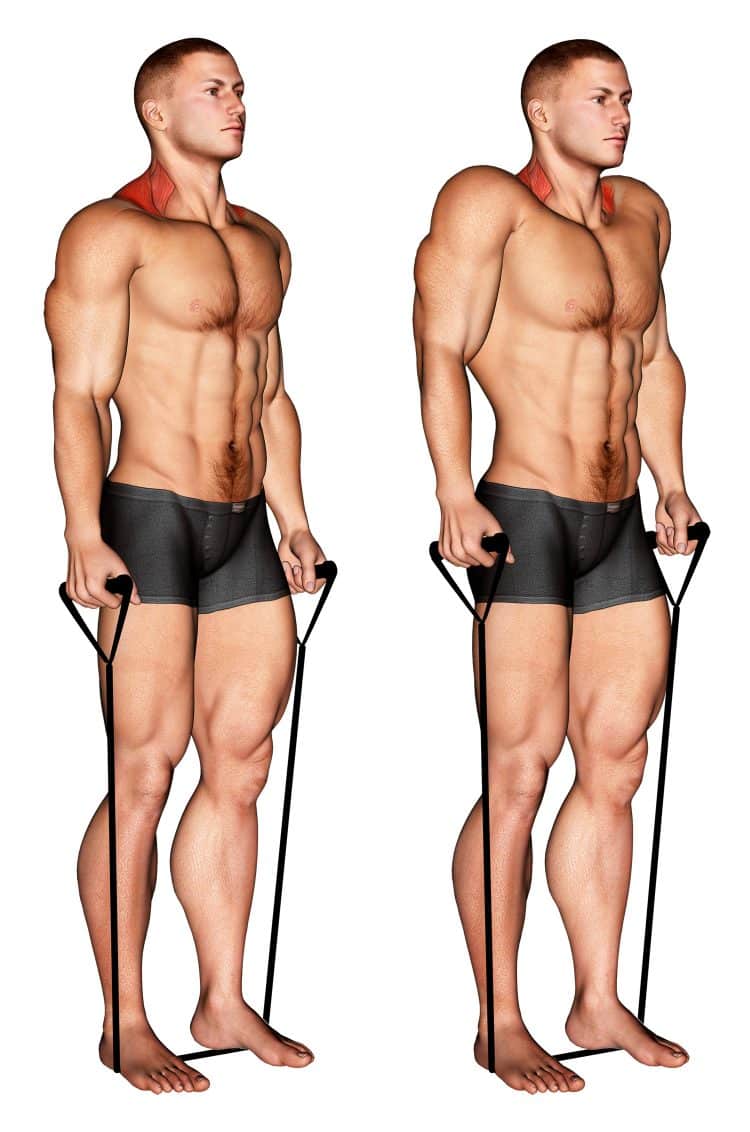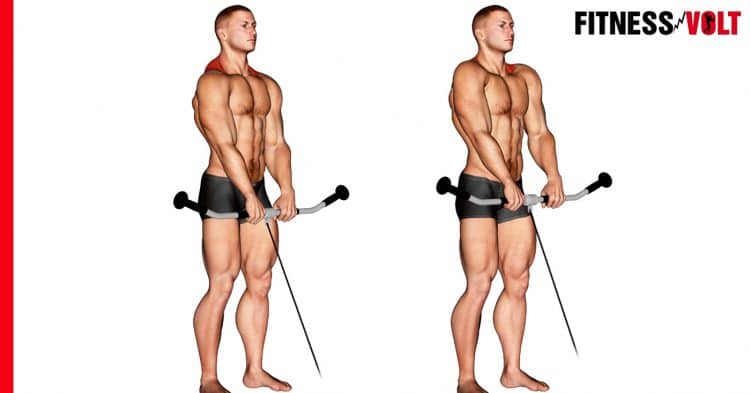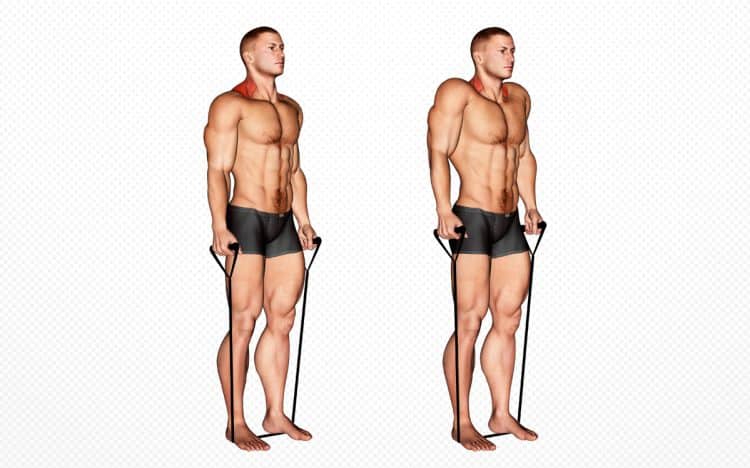Band shrugs are an alternative exercise variation targeting the trapezius muscles utilizing elastic rubber bands that when stretched, create increasingly more resistance. Your trapezius or trap muscles move the shoulders up, down, and back, which are actions that occur in a shrug, and hence effectively activate the upper, lower, and middle traps, respectively. But more so the upper traps that function to lift the scapula. Still, we want to modify the technique for triple stimulation!
Keep in mind though, that since we’re working with bands, we need to be prepared for the drawbacks, and adjust accordingly to get similar results to free weight and machine variations. That means changing the band’s length based on your experience, and using a different band when needed.
So let’s put this idea into action!
Muscles Worked During Band Shrugs
Shrugs are primarily a trapezius muscle exercise, although the upper back and neck region uses more than just the traps to perform multiple movements. Learn about the muscles involved in band shrugs below.

Trapezius
While it’s hard to tell by looking or performing a shrug, your trapezius muscles are divided into upper, middle, and lower sections that cover parts of the neck, back, and shoulders. Like a multi-functional machine, the traps can move the shoulder blades in various directions.
Below we talk about the role of each trapezius muscle.
Trapezius upper – The highest trapezius fibers cover the posterior neck from the occipital bone (Pointy bump on the back of your head) down to the lower neck, before handing off the baton to your middle traps.
The primary purpose of your upper traps is to lift the shoulders toward the ears (Aka shrug), turn, rotate, tilt, and extend the neck, and lift the arms too. Your upper traps are the runt of the litter, being outsized by the middle and lower traps.
Trapezius middle – Spread across the width of your upper back from shoulder to shoulder, middle fibers adduct the shoulder blades or pulls them back and inward toward each other. Also known as retraction.
You won’t hit these middle fibers as much if you shrug straight up and down. But you can modify your posture by leaning slightly forward for more middle fiber stimulation.
Trapezius lower – Also referred to as the inferior traps, these lower fibers sit at the lowest point below upper and middle fibers. Picking up where middle traps leave off, the lower traps form a large “V” with it’s point stopping at the middle back. It’s movement is depressing the scapula or pulling the shoulders down. Lower traps also assist the upper traps during shoulder elevation.
Levator scapulae – Located on the lateral neck and originating below the skull, where it spills down to the scapula, this muscle simultaneously lifts the shoulder blades, with help from traps and rhomboids.
Rhomboids – Lying underneath, and similar in function to the traps, rhomboids consist of major and minor muscles that help form the shoulder girdle at the upper third portion, where they elevate, retract, and rotate the scapula.
How To Do Band Shrugs
If you think moving your shoulders up and down is all there is to a shrug, then you’re mistaken. In fact, you may feel nothing at all, which is wasting your time. It’s a technique that involves proper alignment, positioning and rep execution.,
Steps
- Grab your band in both hands roughly shoulder width apart, then anchor the other end down with both feet. Use a narrower stance for less resistance or a wider stance to make the exercise more challenging.
- Lean very slightly forward at the hips, and let the band pull your arms and shoulders toward the floor to stretch your trap muscles. Relax your arms.
- Now pull your shoulder blades back as far as you can then bend your elbows and pull the band up. Squeeze your traps hard.
- Reverse the motion by protracting the arms forward until you feel a nice stretch in the trap muscles.
- Then you can complete the desired number of repetitions.
Here’s a good example of band shrugs.
Benefits of Band Shrugs
The primary goal of band shrugs and any shrug is to build stronger, more muscular trapezius muscles. Not just to have a more aesthetic looking physique (Although that’s a big reason) but more powerful function of the back and scapula.
Train for a complete physique
There are lots of great physiques out there with subpar trap development. That’s either due to not training them, genetics, or underdeveloped upper traps. But the traps are a significant muscle that will affect how your physique looks, and you have to decide whether to train them hard, or let them develop as a byproduct of other back movements.
Protection against neck traumas
The traps function to help move the neck in various directions. They also help to prevent injuries by absorbing and resisting injury-causing forces commonly occurring in sports competition. Athletes involved in high physical contact activities will especially benefit from training the upper neck and back muscles.
Work your traps without weights
We can see very good reason why bands are very useful for people who train at home. While you can do pull-ups for the back, push-ups for the push muscles, and squats for the legs, how do you work the traps? Movements such as band shrugs, face pulls, and rows fill that gap.
Learn to master the art of band training
Back when the global health crisis forced lifters to train at home, the band finally got its time to shine, and hopefully more people realized its utility.
While it’s not without flaws, band offer a combination of affordability, portability, tension, variety, and versatility. There’s nothing that can yet take its place as a viable substitute for free weights and machines. Not even using your own body weight as a form of resistance offers the sheer options bands give you. Hope we’re not bragging about them too much.
But you get the point. And within that rubber tube or loop, is a built-in resistance system that can be adjusted to your experience level. Aka, making the band shorter for more resistance, or longer for less intensity.
A tier lower than weights and machine variations, bands have their drawbacks but offer many advantages as a home workout substitute.
Common Mistakes During Band Shrugs
Band training requires good form and possibly more attention to detail if your goal is to progress. Here are some band shrug training tips, and what to avoid.
Shrugging straight up and down
Some may prefer to stand straight up and shrug in the same direction. We prefer to lean slightly forward, and shrug both up and back for better traps activation. Most people will feel it better this way, where as the former is hit or miss, and you may not feel much of anything.
No tension at the bottom
In the starting position, your band should be stretched before you do the first rep. If it’s not, then you need to have a wider stance, or grab the band lower to shorten it. We don’t want a flimsy, relaxed band as it also relaxes the muscle and makes the exercise less effective.
Going too light
The issue sometimes with using bands is we don’t know how to use them effectively. If you want to make an exercise easier, use a closer stance, and vice versa. For the decently strong person, using a narrower stance even with a heavy band will not provide a lot of resistance.
Use multiple bands to combine their resistance, or go a band up for better gains.
Rolling the shoulders
If nothing else, rolling the shoulders is simply a waste of perfectly good energy that could be used to train the traps properly, like we train every other muscle group. It may be tempting to roll the shoulders, but it’s not necessary, and never was.
7 Variations and Alternatives of Band Shrugs
In this section, we compiled a few similar shrug variations using bands, in addition to other versions of shrugs that offer as good of, if not a better overall trap training experience.
Close grip band shrug
It might be your preferred flavor to use a close grip during band shrugs. If nothing else, it will force you to use more traps and less pulling with the arms which is good practice for maximizing stimulation in the target muscle.
Wide grip band shrug
Wide grip shrugs give you the opportunity to drive the elbows up and expand the contraction in your traps. Unlike the constriction when using a close grip. Both can be beneficial though, and this one is better utilized by more advanced trainees.
Free weight shrug

The original way to build massive traps, old-school bodybuilders would load a barbell with as much weight as possible, and have at it. Nowadays we’re finding other ways to accomplish the same trap activation with less weight, and more technique. And both are good to be perfectly honest.
But a barbell loaded with a weight relative to your top end strength will give you more strength gains, no question. Just make sure you do it properly and don’t use more weight than what you can comfortably perform good reps with. Leave the hardcore stuff to the more advanced lifters.
Learn proper barbell shrug technique here.
Cable shrug

This is the technique that you can effectively use with less weight that we were referring too. Cable shrugs are more versatile in that you’re not constrained to one position. You can adjust not only the cable machine, but the pulley system allows you to train a muscle in ways that would be more difficult with free weights.
Not to mention, your arm doesn’t have to be close to your body, and that’s one way you can achieve potentially better muscular contractions. You can do it in a few different styles, using any cable attachment/grip that you like, utilizing two arms or doing them one side at a time, based on your preference.
We give cable shrugs a big thumbs up!
Machine shrugs
While using a band implies you may not have access to a gym, most people would probably choose a machine type variation. These days fitness centers are equipped with the most unbelievably ergonomic state of the art contraptions.
Why they often feel better than other forms of training has to do with the design’s mechanisms that apply tension during every little movement. So you get a hybrid of natural motion, and machine tension.
Bodyweight reverse shrug
Most people would never think to train their traps this way but it’s genius for minimalist works. Now, you will be mostly using the lower traps since you have to shrug down, but you’ll still get a little activation in the middle and upper parts too.
Steps
- Sit at the edge of a bench, chair, bed, or seat of your choice.
- Grab the edge of your seat with both hands on either side of your butt.
- Scoot your butt off the edge and use your arms to hold yourself up.
- Lean over forward like you’re doing an ab crunch, bend your elbows slightly, and allow yourself to drop down.
- Now use your traps to pull your shoulders blades all the way down.
- Slowly sink back down, and repeat step 5.
- Do as many reps as necessary.
Here’s a video demonstration. Although we do recommend the slight modification of leaning forward to hit the middle traps more than if you were more upright like shown in the example below.
You could also do the same thing using a pull-up bar, or pulldown machine.
Band face pull
Sort of like the new kid on the block, and here to stay, face pulls are an undervalued posterior technique. They’re typically done using cables, however, bands are the next best thing. Highly praised by training experts more so in recent years, what are the benefits of face pulls?
- Low impact
- Low stress strength building
- Highly concentrated on one area
- Can be done using bands
- Better posture
- Strong lifting performance
All of that can be achieved with a resistance band!
And the beauty of this exercise is that while you can attach is to an object above the head, you can also anchor the band with your feet, lean forward, and work the upper posterior that way.
Learn how to do band face pulls and find the 10 best face pull alternatives here.
FAQ’s
What's the best sets and reps to build the trap muscles?
This is not a question we can answer so simply because many factors determine the best sets and reps for your muscles, such as your training experience, workout frequency, etc.
However, as a general recommendation, you should aim for a minimum of 2 sets per workout and a rep range of 8-25, for decent muscle stimulation.
Keep in mind though, there’s reason to believe, based on common observation from real world results that the traps may respond better to heavy training. Therefore, we suggest using loads that challenge you within that recommended rep range.
What resistance band should I use for this exercise?
You can use any training resistance band as long as it challenges you, and keeps tension on the muscles while using a full range of motion for any given exercise.
So the common bands with separate handles or the long looped circular shaped bands will work just fine! If you’re a beginner start with a medium resistance band, then progress to stronger ones as you advance in your training.
However, if you’re a naturally stronger person, then you might as well start with a heavy band.
Will shrugs give me bulky traps?
Shrugs are one of those gray area-type exercises that don’t appeal to everyone, especially female exercisers. So we can see why many avoid them, even men who want to avoid having big muscles around the neck, in fearing of looking too hulk-like.
After all, the purpose of a shrug is to build these muscles that are often associated with huge bodybuilders or athletes.
The good news is that doing shrugs does not mean you’re going to get big, bulky traps, unless A) that’s your goal and you train accordingly and even then genetics determine your trap muscle growth potential, or B) you’re a non-natural lifter. There’s lots of convincing real world evidence that would suggest the trap muscles respond well to anabolic substances. Although we’re not saying a non-enhanced lifter can’t build big traps though.
For most people, doing a little extra for the traps will enhance your physique, and complement a sexy muscular back which the ladies (And gents) love.
Wrapping Up
If you want better traps but all you have a is a band then band shrugs are your answer. Few minimalist movements challenge the scapula in an upward motion like this variation. You’ll need to understand how to apply the correct amount of tension on the muscles before you see results but this guide has those tips and tricks. A great option in the absence of weight and machines, the band shrug is a viable alternative for isolating these upper back and neck muscles that contribute to a complete physique.
The trapezius also plays an integral in overall lifting performance, and healthy scapular movement. So it pays to utilize isolation techniques like band shrugs to learn the function and movement in this tri-area muscle group.


